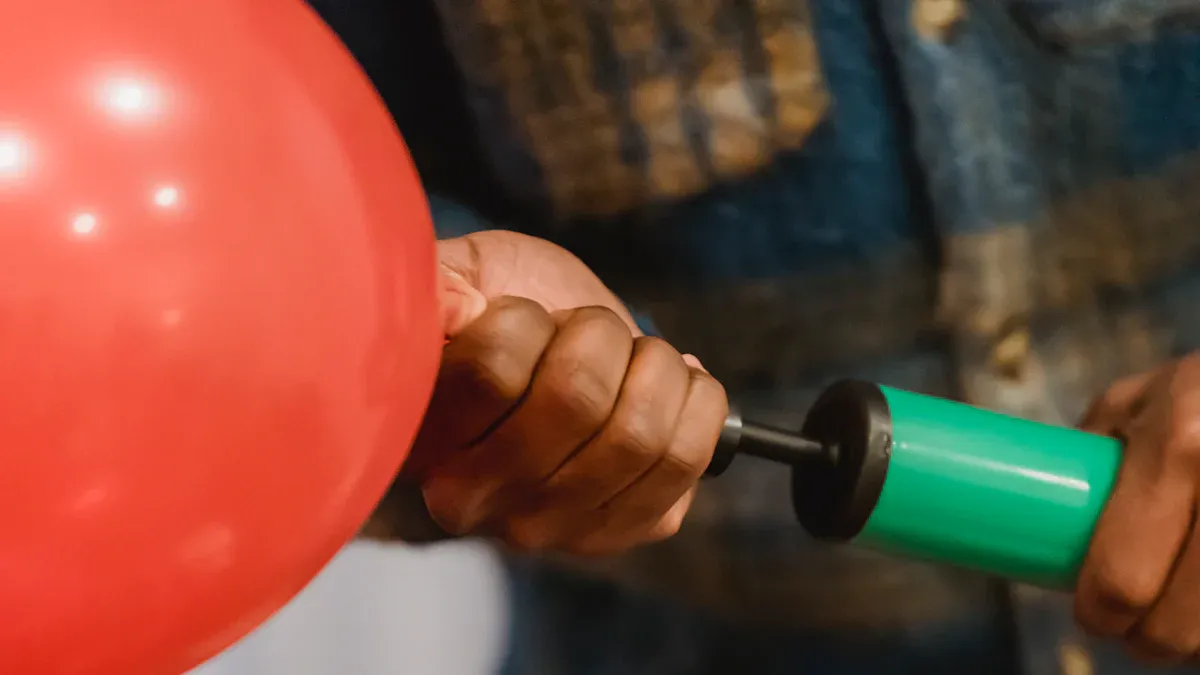
Helium balloons are delicate and react poorly to heat. When left in a hot car trunk, they can expand and burst. During summer, temperatures inside a trunk can rise significantly, creating a dangerous environment for these balloons. You should avoid storing them in such conditions. Instead, keep them in a cooler space to preserve their shape and prevent popping. Understanding how heat affects helium balloons helps you take the right steps to protect them.
Key Takeaways
Park in the shade or use a sunshade to keep balloons cool.
Carry balloons in the air-conditioned part of your car to avoid heat.
Wrap balloons in thermal blankets or put them in coolers to protect them.
Let some air out of balloons so they can expand safely in heat.
Pick Mylar balloons because they last longer in hot weather.
Why Helium Balloons Pop in a Hot Trunk
The Science Behind Helium Expansion
Helium gas reacts to temperature changes. When the temperature rises, helium molecules move faster and spread out. This causes the gas inside the balloon to expand. Balloons have a limited capacity to stretch. If the gas expands too much, the balloon bursts. This is why helium balloons are more likely to pop in hot environments.
The material of the balloon also plays a role. Latex and foil balloons can only handle so much pressure. Heat weakens the material, making it easier for the balloon to break. Even a small increase in temperature can create enough pressure to cause a pop. Understanding this process helps you see why keeping balloons cool is essential.
How Heat Builds Up in a Car Trunk
Car trunks can become extremely hot, especially on sunny days. Several factors contribute to this heat buildup:
Heat shields over mufflers can trap heat due to minimal insulation.
Poor air circulation in the trunk prevents heat from escaping.
Lack of ventilation keeps the hot air trapped inside.
Removing the rear tray of the trunk can improve airflow. This allows cooler air from the passenger cabin to enter the trunk. Without proper ventilation, the temperature inside the trunk can rise quickly. This creates a dangerous environment for helium balloons. Keeping the trunk cool or avoiding it altogether can save your balloons from popping.
Tips to Prevent Helium Balloons from Popping

Keep the Trunk Cool
A hot trunk is one of the main reasons helium balloons pop. To prevent this, you should focus on keeping the trunk as cool as possible. Parking in shaded areas can help reduce heat buildup. If shade is unavailable, use a reflective sunshade on your car’s windshield to block sunlight. You can also leave the trunk slightly open to allow hot air to escape. This improves ventilation and prevents the temperature from rising too quickly.
Another effective method is to cool the trunk before placing the balloons inside. Run your car’s air conditioning for a few minutes with the trunk open. This lowers the temperature and creates a safer environment for the balloons. Taking these steps ensures the trunk remains cool and protects the balloons from heat damage.
Transport Balloons in the Air-Conditioned Cabin
The air-conditioned cabin of your car provides a much safer environment for helium balloons. Unlike the trunk, the cabin allows you to control the temperature. Place the balloons in the back seat or secure them in the passenger area. Make sure the air conditioning is running to keep the space cool.
Avoid placing the balloons near windows where sunlight can heat them directly. If possible, cover the balloons with a light-colored cloth to shield them from heat. Transporting the balloons in the cabin minimizes the risk of popping and keeps them in perfect condition for your event.
Use Insulation to Protect Balloons
Insulation acts as a barrier between the balloons and the heat. You can use a thermal blanket or a large cooler to shield the balloons from high temperatures. Place the balloons inside the insulated container and seal it properly. This traps cool air and prevents heat from reaching the balloons.
If you don’t have a thermal blanket, you can use regular blankets or towels as an alternative. Wrap the balloons carefully to provide an extra layer of protection. Insulation is especially useful when you need to transport helium balloons over long distances or during hot weather.
Additional Precautions for Balloon Safety
Slightly Deflate Helium Balloons
Slightly deflating helium balloons can reduce the risk of them popping in hot conditions. When you leave a small amount of space inside the balloon, it allows the helium to expand without putting too much pressure on the material. This precaution is especially useful when transporting balloons in warm weather or over long distances. You can use this method for both latex and Mylar balloons. However, avoid deflating them too much, as this can affect their appearance and ability to float. A slight reduction in helium volume strikes the right balance between safety and presentation.
Opt for Heat-Resistant Balloon Materials
Choosing the right balloon material can make a big difference in preventing pops. Traditional latex balloons are more prone to bursting in high temperatures because they stretch easily and weaken under heat. Mylar balloons, made from metallic-coated polyester, are a better option. Their shiny coating reflects heat, making them more durable in hot climates. Some manufacturers also produce specialized balloons designed to withstand higher temperatures. These options provide added protection and are ideal for outdoor events or summer celebrations. By selecting heat-resistant materials, you can ensure your balloons last longer and stay intact.
Minimize Time in the Trunk
Reducing the time helium balloons spend in the trunk is another effective way to keep them safe. The longer they remain in a hot, enclosed space, the greater the risk of expansion and popping. Plan your transportation carefully to minimize delays. Load the balloons into the trunk just before you leave and remove them as soon as you arrive at your destination. If you need to make stops along the way, park in shaded areas or leave the car windows slightly open to improve ventilation. Quick and efficient handling ensures your balloons stay in perfect condition.
Common Mistakes to Avoid
Overinflating Helium Balloons
Overinflating helium balloons is one of the most common mistakes people make. When you fill a balloon to its maximum capacity, you leave no room for the helium to expand. This increases the likelihood of the balloon popping, especially in warm conditions. Heat causes helium to expand, and an overinflated balloon cannot handle the extra pressure. To avoid this, always leave some space inside the balloon. Use a pump with a pressure gauge or stop inflating when the balloon feels firm but not overly tight. This simple step can significantly reduce the risk of bursting.
Leaving Balloons in a Closed Car
Leaving helium balloons in a closed car is another mistake that can lead to disaster. Cars, especially when parked in direct sunlight, can become extremely hot. The temperature inside a closed car can rise quickly, creating a dangerous environment for the balloons. Even a short time in these conditions can cause them to expand and pop. Always transport balloons in an air-conditioned cabin or remove them from the car if you need to make a stop. If you must leave them in the car, crack the windows open and park in the shade to reduce heat buildup.
Ignoring Weather Conditions
Ignoring weather conditions can also jeopardize the safety of your helium balloons. Hot and sunny days pose the greatest risk, as high temperatures can cause the helium to expand rapidly. Windy conditions can also damage balloons by pushing them against sharp objects or rough surfaces. Before transporting or displaying balloons, check the weather forecast. Plan accordingly to protect them from extreme heat or strong winds. Being mindful of the weather ensures your balloons stay intact and ready for your event.
Helium balloons can stay intact with the right precautions. Focus on keeping them cool by using insulation or cooling techniques like fans or ice packs. Inflate the balloons shortly before your event to maintain their freshness. Secure them with weights to prevent movement and minimize exposure to heat. Store them in shaded areas if you prepare early. Regularly check for signs of damage and replace any compromised balloons. By following these steps, you can ensure your balloons remain in perfect condition for your celebration.
FAQ
What is the best way to transport helium balloons in hot weather?
Transport helium balloons in the air-conditioned cabin of your car. Keep them away from direct sunlight and windows. Use a light-colored cloth to shield them from heat. Avoid placing them in the trunk unless it is properly cooled or insulated.
Can I use ice packs to keep helium balloons cool?
Yes, you can use ice packs to cool the area around the balloons. Place the ice packs in a cooler or wrap them in towels to avoid direct contact with the balloons. This method helps maintain a safe temperature during transportation.
How long can helium balloons stay in a car trunk?
Helium balloons should not stay in a car trunk for more than a few minutes, especially in hot weather. The heat buildup can cause the helium to expand, increasing the risk of popping. Minimize their time in the trunk to keep them safe.
Are foil balloons better than latex balloons in heat?
Foil balloons are more heat-resistant than latex balloons. Their metallic coating reflects sunlight, making them less prone to popping in high temperatures. If you expect hot conditions, choose foil balloons for better durability and protection.
Can slightly deflated balloons still float?
Yes, slightly deflated helium balloons can still float. Reducing the helium volume allows the gas to expand safely in warm conditions without bursting the balloon. Ensure you don’t deflate them too much, as this could affect their appearance and ability to float properly.
































